The promontory of the Argentario attracts tourists for its various qualities such as the marine environment, the mild climate, the beautiful coasts, the village of Porto Ercole, or its pleasant hinterland appreciated for hiking or mountain biking whose summit reaches 635 meters. Once an island, it is now a peninsula in front of the Orbetello Lagoon with its nature reserve and the beaches of its two isthmus.
Its two villages are on the coast: Porto Santo Stefano is the most important and Porto Ercole is the most charming. Off the coast, the charming island of Giglio is easily accessible.
A scenic road winds above the coast. It does not make the whole tour of the peninsula, due to an ancient collapse on the south coast. You can make a loop by paths, only in 4×4.
The coast is very beautiful, especially discovered from the sea. Its small beaches are not very easy to access from the land, requiring a little walk for the most beautiful, very busy in high season. Indeed, much access to the coast is privatized, knowing that the luxury villas of the Italian show-bizz (including politicians, cvds) are numerous here.
The interior of the promontory is very hilly and culminates with Mount Telegrafo at 635 meters above sea level.
See also at the end of page Touristic map of Monte Argentario
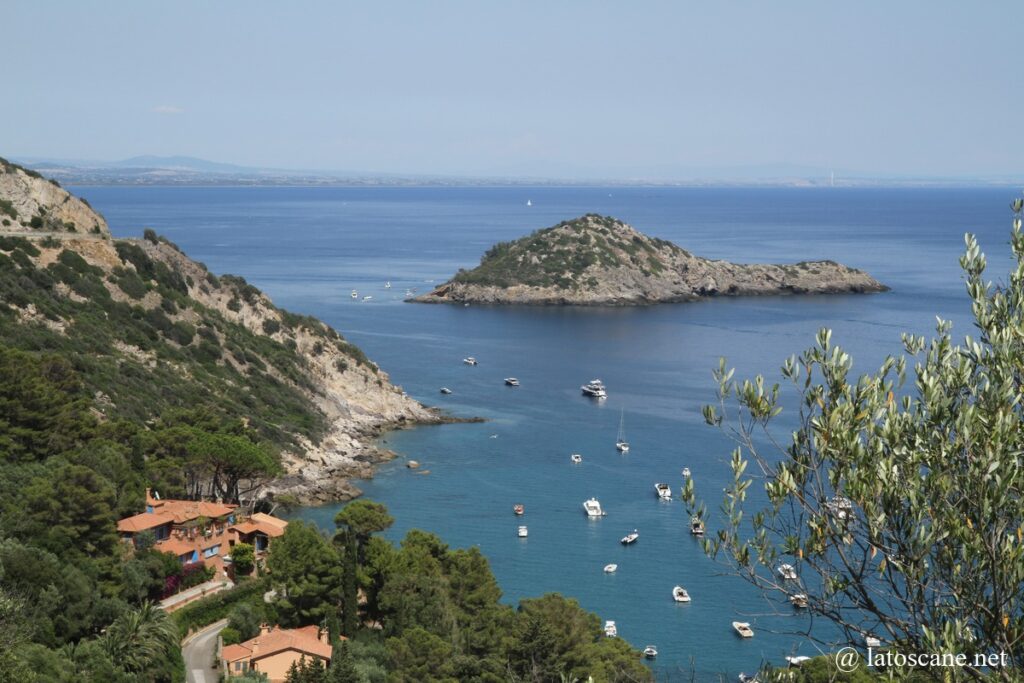
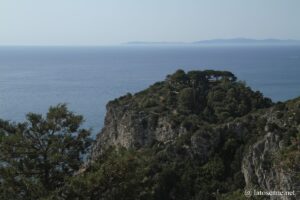
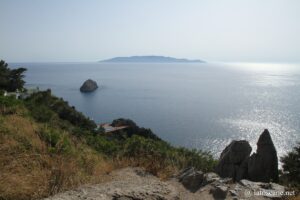
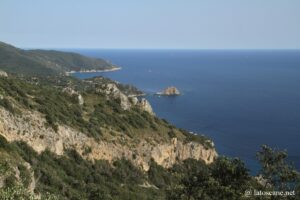
Porto Ercole
Porto Ercole is more intimate than Porto Santo Stefano, a former fishing village listed among the most beautiful villages in Italy since 2004, with a beautiful marina where yachts dock. Boat trips depart from here to discover the charming coast with its coves and beaches.
The village is divided in two, with the modern district which is the most frequented facing the marina, and on a relief south side is the charming historic village with its alleys, panoramic terrace, church Sant’Erasmo, or the 16th-century Spanish Governor’s Palace flanked by the bastion of Santa Barbara.
In addition to the Rocca Spagnola south of Porto, two 16th-century Spanish fortresses protected Porto Ercole: the Forte Filippo on the north side of the promontory, and the Forte Stella in the south which can also be visited and enjoy one of the most beautiful panoramas of the Argentario, especially appreciated at sunset.
It was at the old hospital of Porto Ercole that the famous Caravaggio lived his last days, having been found dying – we do not know much more – on the nearby beach of Feniglia on 18 July 1610 while he had embarked in Naples. His remains were buried in the old San Sebastiano cemetery where the centre of the new village was built.
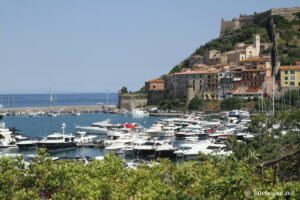
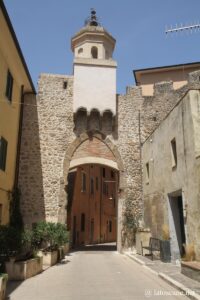
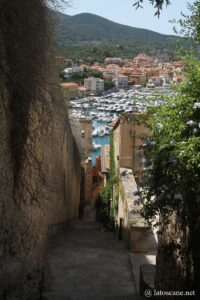
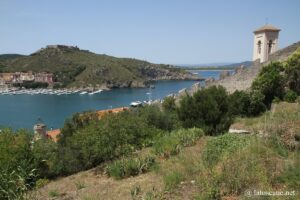
Porto Santo Stefano
Porto Santo Stefano is the most important tourist resort of the Argentario. In addition to its commercial and tourist ports, it has a historic center with shops, and especially a pleasant pedestrian promenade on the seafront with its cafes, restaurants and marina. You can take the boat to the islands of Giglio and Giannutri.
The centre of the village is nothing special, except for an old centre with alleys and stairs, dominated by the 17th century Spanish Fortress, the main building of Porto Santo Stefano. The latter hosts the museums Memorie sommerse, with underwater archaeological discoveries (Roman objects, wreck of the 6th century BC) and Maestri d’Ascia devoted to the history and traditions of the territory, as the shipbuilding industry with fishing boats.
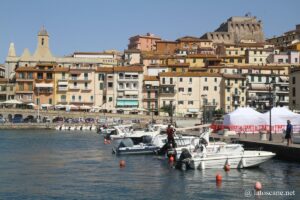
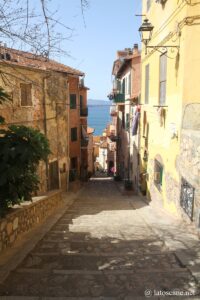
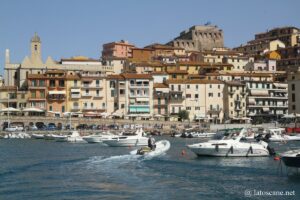
Argentario beaches
The two isthmus, the tomboli of Giannella and Feniglia which border the lagoon of Orbetello have two long comfortable sandy beaches.
The coves of the promontory are generally reachable with a little walk and worth it, being moreover rarely crowded except for the most accessible in high season. Here is a selection.
Beaches near Porto Santo Stefano
Let us mention near Porto Santo Stefano, first the most accessible beaches that are located east of the village on the road to Orbetello, with the small beach of Bagni di Domiziano, the Spiaggia della Soda with its small bay along the road, the Cala Pozzarello, the Bionda beach, and the Cantonera right at the entrance of the village.
Along the scenic road to the west of Porto, there are coves, first of all the Cala Grande with its three small beaches. It is one of the largest beaches in the Argentario, accessible by 5-10 minutes walk and free access, with beautiful seabed.
A little further, a steep path of almost 15 minutes leads to the Cala del Gesso, one of the most beautiful with its turquoise waters, free access, with small pebbles, very busy in high season. Further on is the tiny Cala Piccola.
Beaches near Porto Ercole
North of Porto Ercole are two beaches in the flat part. The nearest beach is Spiaggia delle Viste, a free-form beach with sand and pebbles. Cala Galera is another beautiful beach with easy access, low and sandy, with a free section.
Beyond Porto, the coast is steep with beautiful beaches (more accessible by boat), first at the foot of Fort Stella, the Spiaggia Lunga, accessible by a steep path of almost 200 meters.
Further on, the beautiful beach of Acqua Dolce is accessible by a path that passes behind the Hotel Pellicano, with a free section.
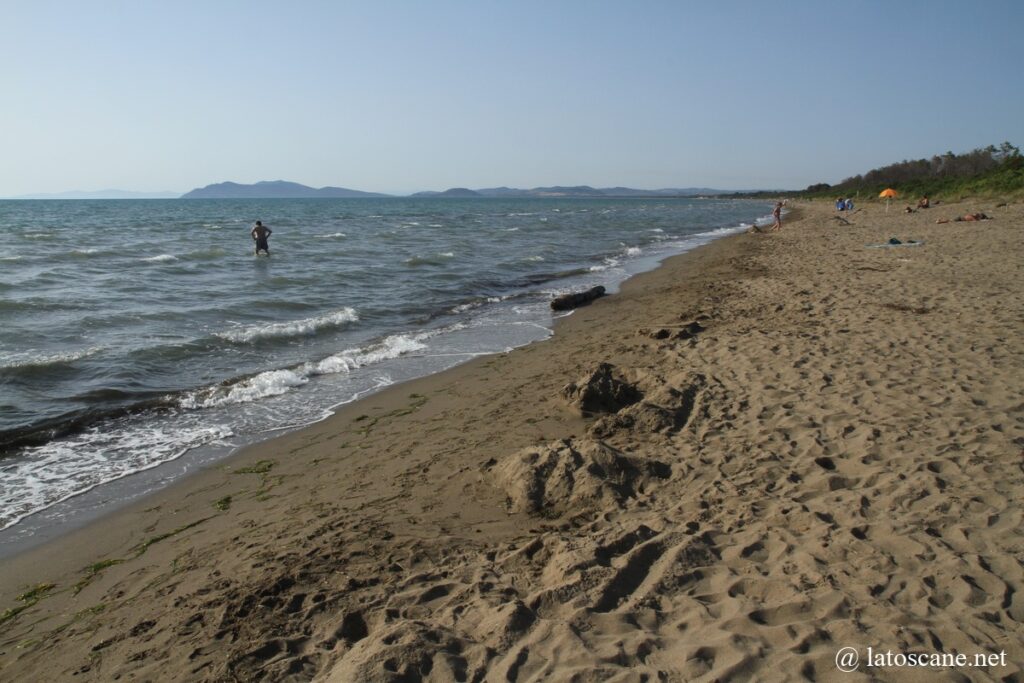
Excursions
Coming from Orbetello, you can go straight up to the Convent of the Passionists Fathers by the road that reaches the top of the promontory. The sanctuary emerges from the maquis at 273 meters, from where you can enjoy a view of the lagoon. You can continue the climb up to the top of Argentario, the Monte Telegrafo at 635 meters with its superb panorama towards the islands of Giglio, Giannutri and Montecristo.
To the southwest of the promontory, the cliff of Capo d’Uomo is gigantic and equipped for climbing, with at the top the remains of the tower of Capo d’Uomo and a superb view.
In the relief behind Porto Santo Stefano, the Torre Argentiera is a suggestive medieval tower.
At the entrance of the promontory towards Porto Ercole, a beautiful nature reserve runs along the Feniglia beach, which can be walked or cycled with a path through the pine forest and maquis.
Spanish Forts
In the mid-16th century, the Argentario was owned by the Spanish crown which built many well-preserved forts: at Porto Ercole, the Rocca Spagnola (private), the Forte Filippo (private) and the Forte Stella (open to the public); in Porto Santo Stefano in the center is another Fortezza Spagnola (open to the public) with the museum.
Private forts can be visited on reservation.
Lagoon and surroundings
Orbetello is at the entrance of the Argentario, in a remarkable situation, surrounded by the lagoon. It is an interesting city for its history and historical testimonies. Orbetello wetland is known for its biodiversity, a place where migratory birds such as flamingos, white herons and ash-lilies can pass through.
The Giglio Island is one of the most beautiful of the seven islands of the Tuscan archipelago, close to the Argentario and therefore quickly reachable by boat from Porto Santo Stefano (in almost an hour). It has coves and beaches worthy of the most beautiful postcards with its transparent and turquoise waters at the foot of the hills of maquis. Its environment is quiet, the urbanization weak with its three small villages, without excessive attendance.
In the vicinity, on the mainland, there is the Maremma park, with Talamone, Ansedonia (the ruins of the Roman city and its beaches), the amazing Garden of Tarot in Capalbio, or more inland the Area del Tufo including its perched villages of Etruscan origin.
Touristic map of Monte Argentario
If you see this after your page is loaded completely, leafletJS files are missing.
Sources and links
- Background information: en.wikipedia.org
- Travel portals and blogs: www.tuttomaremma.com, www.finestresullarte.info, www.visittuscany.com
Articles about the Argentario
- Monte Argentario
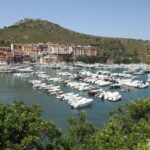 The Monte Argentario is a very beautiful site to the south of the Tuscan coast, in the province of Grosseto. It attracts visitors for its various features: the marine environment, ...
The Monte Argentario is a very beautiful site to the south of the Tuscan coast, in the province of Grosseto. It attracts visitors for its various features: the marine environment, ... - Orbetello and its lagoon
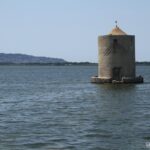 Orbetello is a small, quiet town with a special position on a spit of land in the middle of the beautiful lagoon of 26 km 2, where the road continues ...
Orbetello is a small, quiet town with a special position on a spit of land in the middle of the beautiful lagoon of 26 km 2, where the road continues ... - Hotel in Argentario
 Find accommodation available on the Monte Argentario in Tuscany, among hundreds of hotels, rooms, guest houses and apartments
Find accommodation available on the Monte Argentario in Tuscany, among hundreds of hotels, rooms, guest houses and apartments
No Comments Yet